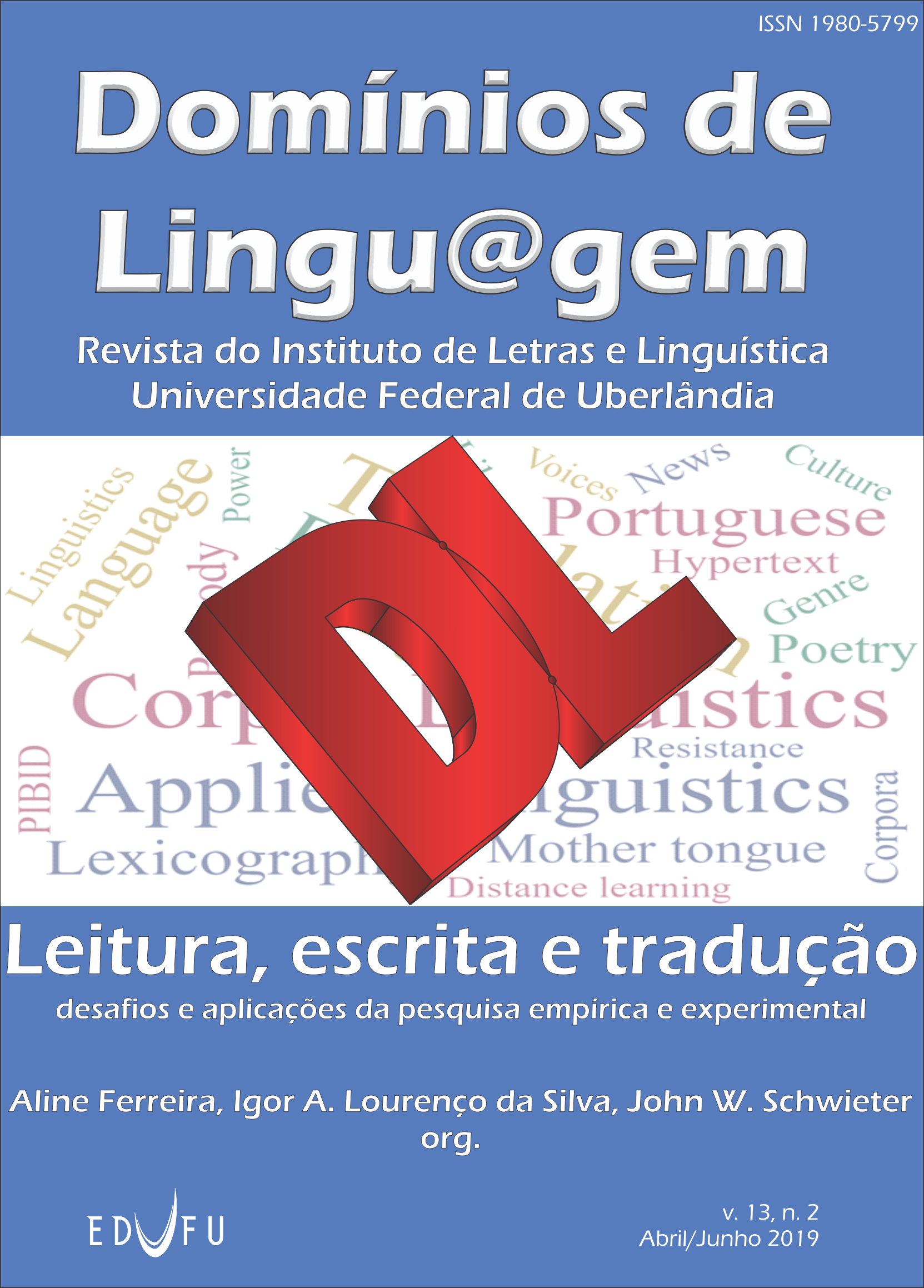Pauses in a translation task and perceived level of Translation Task Difficulty
DOI:
https://doi.org/10.14393/DL38-v13n2a2019-10Palavras-chave:
Percepção do Nível de Dificuldade de Tradução, Esforço Cognitivo, L1 e L2, Pausas, InputlogResumo
Uma tarefa de tradução, do inglês para o espanhol (castelhano), foi realizada por 5 estudantes de pós-graduação e 1 estudante de graduação altamente proficientes em inglês e espanhol. O software Inputlog foi usado para registar todas as pausas e pressionamentos de teclas durante a tarefa de tradução. Várias relações foram examinadas com o objetivo de tirar conclusões sobre o esforço cognitivo durante a tarefa de tradução. A primeira relação examinada foi entre os resultados auto-reportados da Primeira Língua (L1) e a Fluência Verbal em L1 e na Segunda Língua (L2). Nós previmos que os participantes teriam pontuação mais alta no Teste de Fluência Verbal em sua L1, acontecendo isso na verdade com 4 dos 6 participantes. Investigámos também a relação entre a pontuação do Teste de Fluência Verbal e o nível percebido de dificuldade da tarefa. Nós previmos que a tarefa de tradução para o espanhol seria percebida como menos difícil para os participantes que tiveram pontuação mais alta em espanhol na pontuação de fluência verbal. Este resultado foi apenas o caso de um em cada 3 participantes que tiveram pontuação mais alta em espanhol no Teste de Fluência Verbal. Também analisamos a relação entre o grau de satisfação com o texto alvo e o nível percebido de dificuldade da tarefa e previmos que os participantes que percebessem a tarefa de tradução como mais difícil ficariam menos satisfeitos com o produto final. Este foi o caso de 4 de 6 participantes. Em seguida, analisou-se o tempo total da tarefa e o tempo total de pausa. Por fim, foi investigado o número de pausas e o tempo médio de pausa em diferentes níveis de segmentação. Os resultados encontrados são consistentes com pesquisas anteriores, nas quais as pausas eram mais frequentes nos níveis mais baixos do segmento, em oposição aos níveis mais altos do segmento. Os resultados deste estudo sugerem que as pausas são, de fato, um indicador de esforço cognitivo durante uma tarefa de tradução e que a tradução na L1 do participante pode ajudar a aliviar parte desse esforço cognitivo.
Downloads
Referências
IMMONEN, S. Translation as a Writing Process. Pauses in Translation vs Monolingual Text Production. Target, 18 (2), p. 313-336, 2006 DOI https://doi.org/10.1075/target.18.2.06imm.
JAKOBSEN, A. L. Instances of Peak Performance in Translation. Aufsätze, No. 3, Copenhagen, p. 111-116, 2005. DOI https://doi.org/10.1515/LES.2005.111.
JAKOBSEN, A. L. The development and current state of translation process research. In: BREMS, E.; MEYLAERTS, R.; VAN DOORSLAER, L. (ed.). The Known Unknowns of Translation Studies. Amsterdam, The Netherlands/Philadelphia, PA: Benjamins, 2014. p. 65–88.
LACRUZ, I., DENKOWSKI, M.; LAVIE, A. Cognitive demand and cognitive effort in post-editing, 2014, AMTA.
LEIJTEN, M.; VAN WAES, L. Keystroke Logging in Writing Research: Using Inputlog to Analyze and Visualize Writing Processes. Written Communication, 30 (3), p. 358-392, 2013. DOI https://doi.org/10.1177/0741088313491692.
MARINOVA-TODD, S.; MARSHALL, D.; SNOW, C. Three misconceptions about age and L2 learning. TESOL Quarterly, 34 (1), p. 9-34, 2000. DOI https://doi.org/10.2307/3588095.
MUÑOZ MARTIN, R. ; MARTIN DE LEON, C. Fascinatin’ rhythm-and pauses in translators’ cognitive processes. Hermes - journal of language and communication in business, 2018, Manuscript submitted for publication. DOI https://doi.org/10.7146/hjlcb.v0i57.106192
O’BRIEN, S. The borrowers: Researching the cognitive aspects of translation. Dublin City University: Ireland, 2013. Unpublished manuscript.
SCHILPEROORD, J. It’s about Time. Temporal Aspects of Cognitive Processes in Text Production. Amsterdam: Rodopi, 1996.
Politics this week, 17 feb. 2018. Available at:
https://www.economist.com/taxonomy/term/7/0?page=101 Last Access: 2 June 2019.
Downloads
Publicado
Edição
Seção
Licença
Autores que publicam nesta revista concordam com os seguintes termos da licença Creative Commons
CC BY-NC-ND 4.0: o artigo pode ser copiado e redistribuído em qualquer suporte ou formato; os créditos devem ser dados ao autor original e mudanças no texto devem ser indicadas; o artigo não pode ser usado para fins comerciais; caso o artigo seja remixado, transformado ou algo novo for criado a partir dele, o mesmo não pode ser distribuído.
Autores têm autorização para assumir contratos adicionais separadamente, para distribuição não-exclusiva da versão do trabalho publicada nesta revista (ex.: publicar em repositório institucional ou como capítulo de livro), com reconhecimento de autoria e publicação inicial nesta revista.









